
Meet the three Ps sabotaging your metabolism: PUFAs, Phytoestrogens, and Pesticides.
They’re hiding in our modern food system more than ever before, quietly signaling your body to slow metabolism, store fat, and disrupt hormones.
The consequences are hard to ignore:
- - Metabolic rates are declining (r), meaning we are burning less calories at rest
- - Obesity is rising (r) and we are gaining weight eating fewer calories (r)
- - Infertility is increasing (r)
- - Testosterone levels are dropping (r)
- - Chronic disease and cancer rates are climbing (r)
- - And life expectancy is shrinking (r): we’re dying younger
That’s why we avoid these three Ps in our seed-to-fork food system. Because when you farm the old-fashioned way, they don't have to be in your food.
> Our livestock graze on chemical-free pastures, not confined in feedlots or CAFOs.
> We custom make our corn-, soy-, flax-free feed for our pasture-raised chickens and pigs, using ingredients from our regenerative row crop farm partners.
> And our produce comes from small regenerative farms using no chemicals or pesticides.
So... where do these Ps come from?
Over the last century, our food system has changed... dramatically. Sure, we’ve seen a rise in processed foods, synthetic dyes, preservatives, and hard-to-pronounce ingredients.
But some of the most damaging changes are the ones that don’t show up on labels and remain invisible to the average consumer.
The animals we eat are no longer raised or fed the way they were just a few generations ago. Instead of grazing diverse pastures and eating traditional diets, they’re often confined, heavily medicated with pharmaceuticals, and fed PUFA rich soy, corn products, and industry byproducts laced with agrochemicals. And pesticides aren’t just used on feed crops, they’re also used on pasture, in confinement buildings, and are sprayed on produce and grains.
These upstream decisions have quietly reshaped the composition of our food, diminishing nutrient density and increasing our exposure to metabolism disrupting compounds.
These aren’t minor shifts in the food chain, they’re among the most damaging. Because these compounds don’t just go away; they show up in the food you eat. And their individual effects don’t just add up... they compound.
So while the food system has changed, our biology hasn’t.
We’re still wired to thrive on traditional, unaltered food - the kind our ancestors ate for generations. But today’s food system sends the wrong signals to our bodies: slowing metabolic function, disrupting hormonal balance, draining energy production, and promoting fat storage.
In short, it’s pushing us into hibernation mode - a biological survival mechanism meant to help us endure winter and food scarcity by conserving energy and storing fat. But for many today, that “winter” never ends.
If we want to support our metabolic and hormonal health, we need to return to the practices that nourished generations before us - before industrial ag flooded the food supply with compounds that interfere with energy, hormones, and long-term wellness.
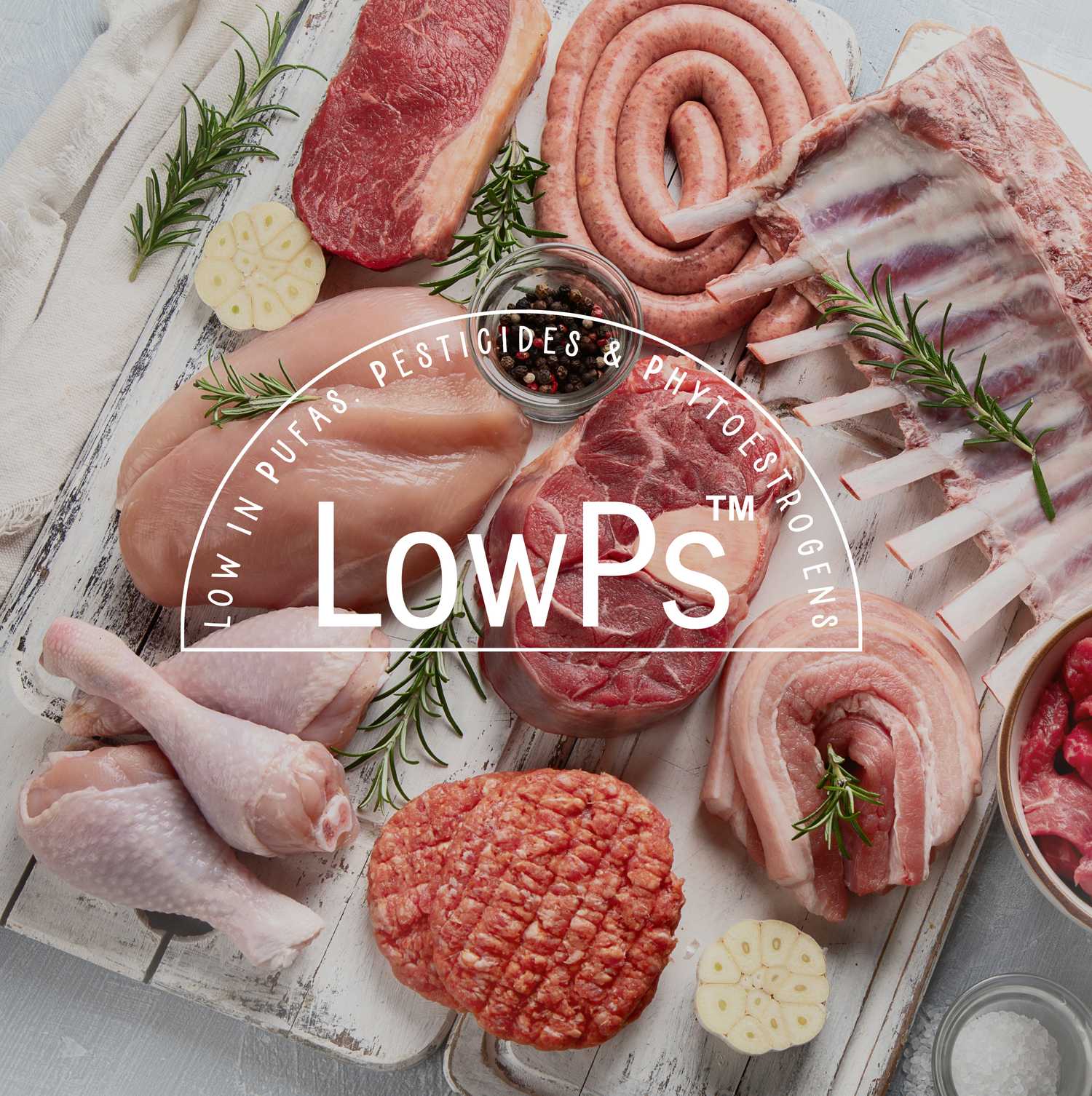
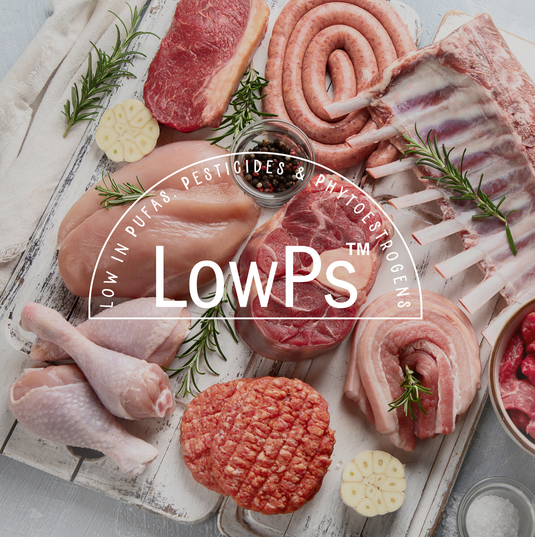

The LowPs™ Standard
The LowPs™ product standard goes beyond what Organic requires. It'ss about undoing decades of food misinformation and returning to traditional, nourishing food production, bringing truly healthy, farm-fresh food back to your table.
So... what do we mean when we say Nourish Food meets the LowPs™ standard?
Our food is low in PUFAs, low in phytoestrogens, and produced without pesticides, to produce food that better supports your long term health.
But in today’s industrial food system, you can’t just slap a label on something and call it LowPs™. Meeting these standards requires full control over the entire process: from seed to feed to fork.
Many farms (even pasture-raised ones) rely on off-the-shelf, conventional feed that doesn’t meet the LowPs™ standard. We chose a different path. One that demands more time, more effort, and greater investment, because your health is worth it.
It all starts with our regenerative row crop partners, who grow clean feed ingredients without relying on toxic pesticides.
From there, we custom-formulate our own feed blends: crafted to be low in PUFAs and phytoestrogens.
We then work with two dedicated mills to produce and deliver this feed directly to our farm partners.
These farmers raise livestock on chemical- and pesticide-free pastures, working in harmony with Mother Nature to produce food you can trust, designed to minimize your exposure to the metabolism-disrupting compounds.
Now, let’s dive into the why: why these three Ps have become major drivers of metabolic dysfunction, hormonal imbalance, and the rise of chronic disease.
And why reducing your exposure to these compounds is one of the most powerful steps you can take for long-term health.
Note while reading through this information: don’t panic, be proactive. Understanding these issues is empowering. It sheds light on why the quality of your dietary fat sources matters so much. It’s not just about macronutrients; it’s about the actual composition of the fat you’re eating and what’s stored in that fat.
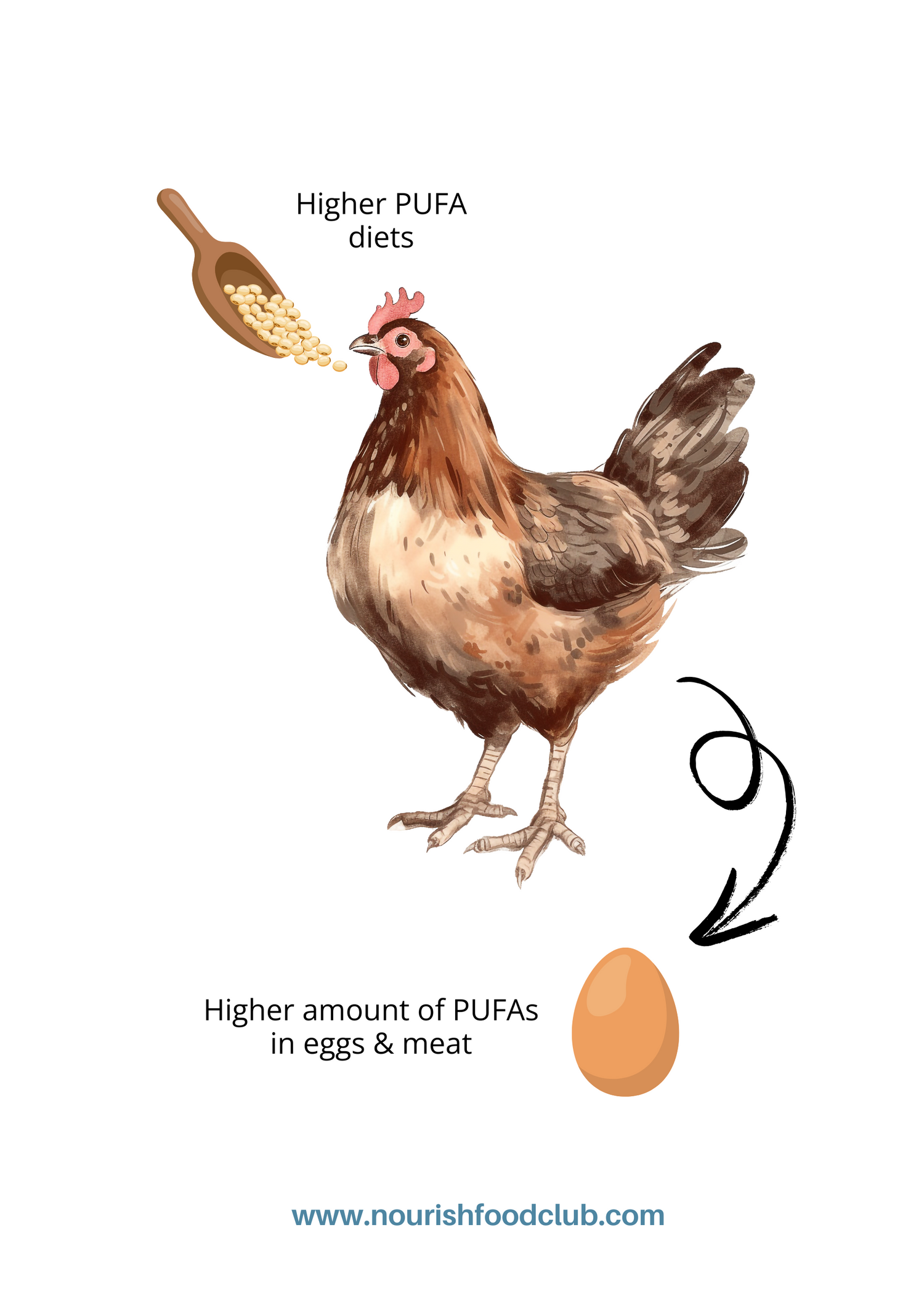
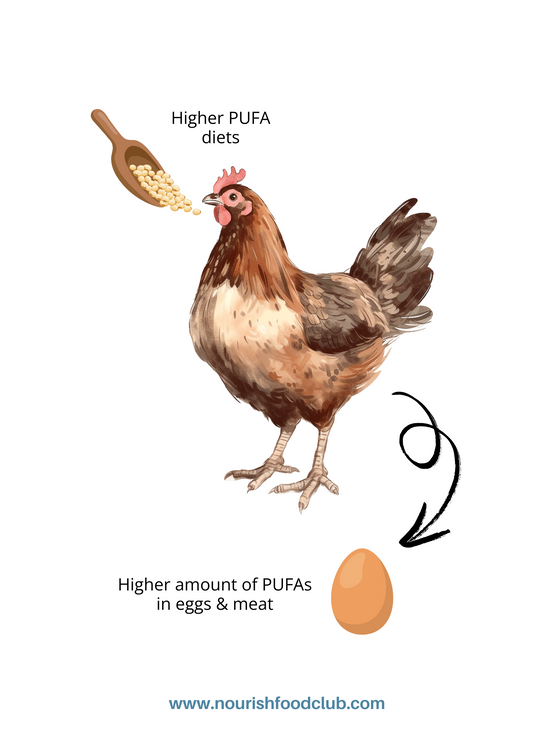

1. pufas - why the fat composition matters
The fats we eat are made up of a mix of saturated, monounsaturated, and polyunsaturated fatty acids (PUFAs). But here’s something most people don’t realize: the fatty acid profile of animal fats can be completely changed by what the animals are fed.
Over the past few decades, major shifts in livestock feed - such as increased use of PUFA rich ingredients like soybeans, corn oil, vegetable oils, dried distillers grains (DDGS), canola, & more - have led to a dramatic rise in PUFA content in the foods we eat. As a result, the fat in pork, chicken, turkey, and eggs now contains significantly more PUFAs than ever before (r,r) increasing your PUFA consumption even if you are avoiding seed oils and processed food.
This matters, because consuming more PUFAs doesn’t just change your fat intake - it alters the fatty acid composition within your body, reduces energy production, increases oxidative stress, and slows your metabolism.
Not all fats are created equal. And the animal fats we consume today are fundamentally different from those our ancestors relied on for nourishment. They've been PUFAd.
Collapsible content
you are what they eat
When livestock consume more PUFAs, the animal products we eat contain a higher PUFA content (r,r) which are often the same types of fat in seed oils/vegetable oils.
And when something goes up, something else goes down. In this case, as PUFA levels rise, the amount of health-supporting saturated fats drops.
So, what does the science say about how livestock diets change the fat they produce?
“Eggs laid by hens fed the diet containing soybean oil had a large amount of n-6 polyunsaturated fatty acids (PUFA).” (r)
“Monounsaturated fatty acid (MUFA) and saturated fatty acid (SFA) content of [chicken] thigh decreased linearly as the inclusion of dietary PUFA increased, whereas the relationship between PUFA content of feed and [chicken] thighs was exponential.” (r)
“Saturated FA levels in AAT [chicken fat tissue] decreased significantly both linearly and quadratically with an increase in dietary PUFA….The concentration of linoleic acid increased significantly with an increase in dietary PUFA.” (r)
And yes—this applies to organic and pasture-raised products too. Chickens, pigs, and turkeys can’t survive on grass alone, so they require supplemental feed. And organic soybeans still contain just as much PUFA as conventional soybeans.
What about trendy ‘corn & soy free’ products? Unfortunately, many of these simply swap one problem for another. Ingredients like canola, flax, sunflower, sesame, and safflower are often used as replacements—yet all are rich in PUFAs and raise PUFA levels in the final product. Numerous studies confirm this: for ex, flaxseed increases PUFA levels in eggs (r,r), and sesame oil does the same. (r)
While this issue is most pronounced in poultry and pork, dairy products are also starting to show shifts in fatty acid profiles. (r) Feed innovations like “rumen bypass” and oilseed additions are changing the fat content of milk. For example - research shows that DDGS feeding can raise milk’s PUFA content by up to 39% (ref) while decreasing health-promoting saturated fats. (ref)
Let Mother Nature be!
We’ve radically altered the fatty acid composition of our diets — and in doing so, we’ve rewired our metabolic signaling, slowing our metabolic rate and ramping up fat making enzymes.
But the problem doesn’t stop there.
PUFAs aren’t just a concern because of how much we’re consuming. They’re chemically unstable and prone to oxidation—especially under heat, like when you cook.
Cooking PUFA-rich meat leads to the formation of harmful compounds called lipid oxidation products, such as MDA (malondialdehyde), 4-HNE (4-hydroxynonenal), and other aldehydes. (r,r,r) These byproducts damage cells, increase inflammation, and are linked to the development of chronic diseases.
One study found that the level of these oxidation products in cooked meat rises directly with the PUFA content in the raw meat (r). Another study showed that eggs higher in PUFA oxidize more readily (r, r. r) reducing their shelf life, nutritional value, flavor, and aroma. (r)
What about Omega-3 enriched eggs? Chicken? Milk?
Let’s skip those. Omega-3s are still PUFAs—just a different variety. While small amounts are beneficial, more is not always better. To “enrich” these products, animals are often fed flax, algae, or fish oil (r)—industrial byproducts that unnaturally spike PUFA levels and worsen oxidative instability in meat (r,r,r), eggs (r,r,r,r), and milk. (r)
One study put it plainly: “Flaxseed inclusion as a fat source in a hen’s diet has been found to enhance the LC n-3 PUFA content but causes a significant decrease in the oxidative stability of eggs.” (r)
And remember: eggs aren’t naturally high in omega-3s (r), and forcing them to be can come with unintended consequences.
Instead of artificially manipulating the fatty acid profile of animal products, we believe in returning to nature.
Let meat, eggs, and dairy retain their natural, stable fat composition—the way they were originally intended.
Learn more about the science behind PUFAs here.
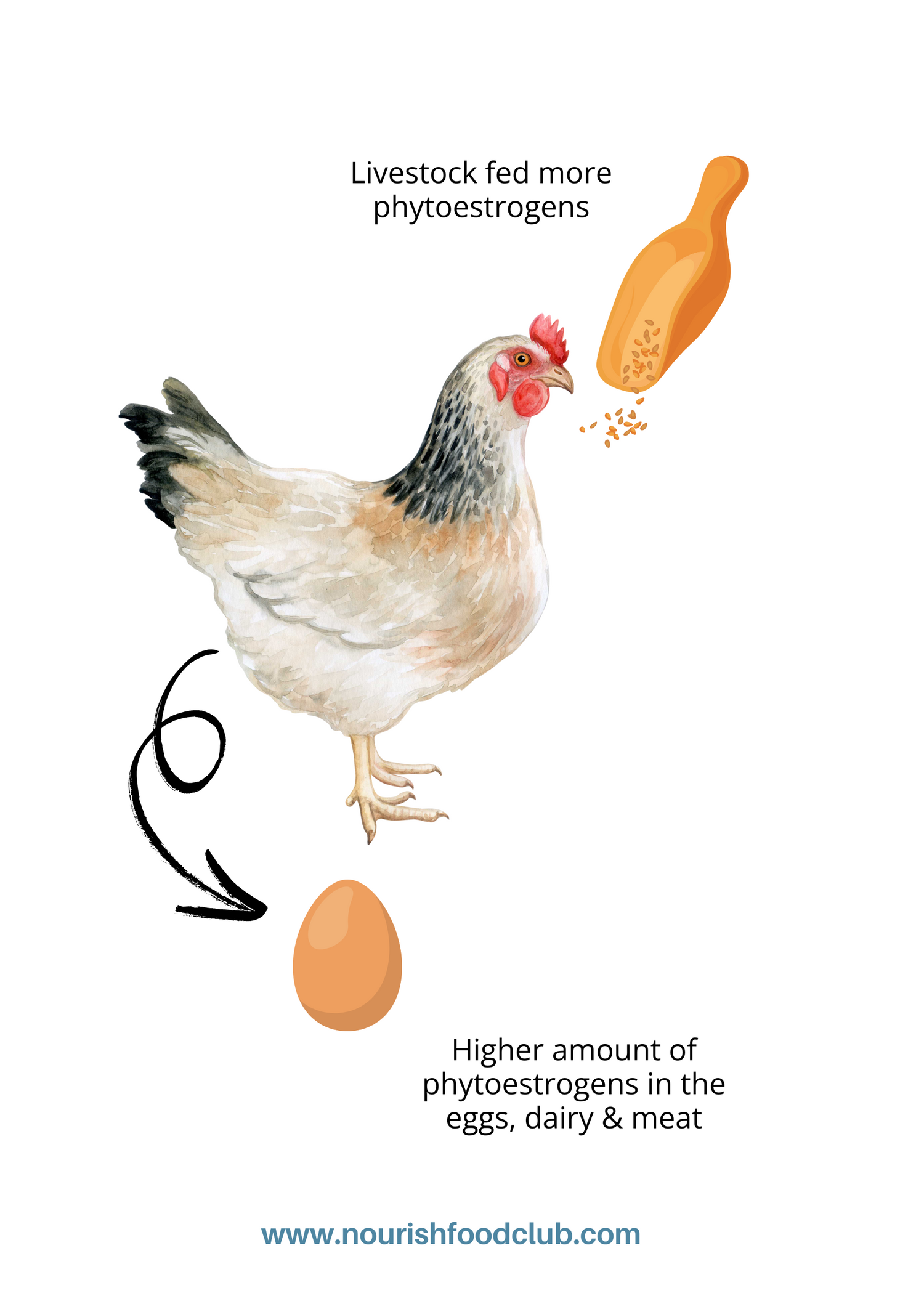
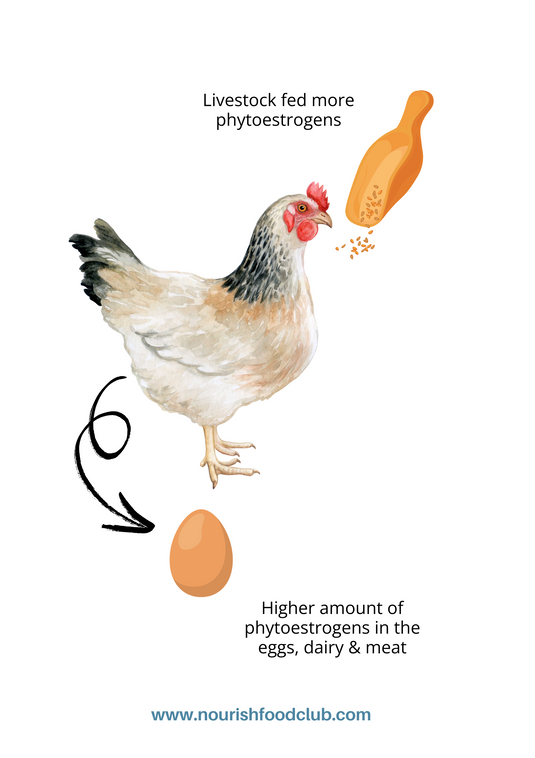

2. hormone disrupting phytoestrogens
Hormonal imbalances are everywhere. Infertility rates are climbing. Breast cancer has increased by 210% since 1970. Testosterone is in free fall.
Why?
We’re being exposed to hormone-disrupting compounds (endocrine disruptors) everywhere we turn. They’re in personal care products, cleaning supplies, clothing, and now… in our food.
In addition to the rise of PUFAs in our food supply, another major change is our growing exposure to phytoestrogens - plant-derived compounds with estrogen-like effects - through soy and flax (which contain the highest levels of phytoestrogens), and through animal products from livestock fed these ingredients. Similar to PUFAs, exposure to these compounds in high quantities interfere with metabolic signaling inside of our bodies.
Collapsible content
why you don't want more phytoestrogens
Phytoestrogens are plant estrogens. While they’re not identical to the body’s natural estrogens, they’re close enough in structure to stimulate our estrogen receptors and disrupt hormonal balance. (r) That means phytoestrogens are endocrine disruptors, interfering with hormone production and contributing to the widespread issue of estrogen dominance.
The hormonal impacts of phytoestrogens are broad and significant.
High intake of phytoestrogens has been linked to hormonal abnormalities in women, men, and even children. (ref)
Recent 2024 research confirms that phytoestrogens can alter neuroendocrine and reproductive function, especially during critical developmental windows. (ref) Animal studies show that exposure during gestation and infancy can permanently alter the hormonal system, leading to reproductive organ malformations, early puberty, reduced fertility, and increased risk of reproductive tract cancers (ref).
Phytoestrogens also interfere with sex steroid-binding protein (SHBG), which regulates the bioavailability of sex hormones such as testosterone and estradiol.(ref)
As phytoestrogen exposure rises, free testosterone decreases (ref)
Dr. Connealy, a metabolism-focused doctor that treats cancer, explains:
“While flax’s phytoestrogens are not as immediately powerful as estrogens in medications like birth control or HRT, they can accumulate in the body over time and disrupt hormone balance. They act on estrogen receptors, interfere with the body’s natural estradiol metabolism, and increase the overall estrogenic burden, which directly contributes to cancer.
One of the biggest issues with flax is that it is often marketed as a “natural” or “balancing” estrogen source when, in reality, it adds to the estrogen load rather than truly balancing hormones. “ (link)
Phytoestrogens are powerful compounds that require caution. Despite being promoted as beneficial for boosting estrogen, there is a major misconception: that women need more estrogen as they age. This is not always true.
Many believe they’re low in estrogen based on serum labs, but serum estrogen doesn’t tell the full story... estrogen stored in tissues is what matters. Estrogen can appear low in the blood, but be elevated in tissues, (r) leading to hidden dominance (which is a growing problem for both women and men!) When stored estrogen is measured, most people show signs of estrogen dominance, thanks to high-PUFA diets, synthetic hormones (like birth control), and exposure to environmental estrogens from pesticides, plastics, and yes - food.
There is a growing estrogen dominance epidemic.
Estrogen and progesterone are meant to work in harmony, like yin and yang. But modern humans are often deficient in progesterone, while being overloaded with estrogen. Some studies show high phytoestrogen intake lowers progesterone levels (r), which only adds fuel to the fire.
The truth? The medical system has pushed synthetic estrogen for decades because it’s profitable. In fact, the global menopause market is projected to hit $24.4 billion by 2030. (r) No wonder there’s an incentive to keep the estrogen train going.
Meanwhile, waste products from the flax and soy industries—once used to make paint, not food—are being marketed as health foods, while exposing us to more and more estrogenic substances that we don’t need in our diet.
Estrogen dominance doesn’t just mess with hormones - it slows your metabolism, especially when paired with PUFAs. How? Elevated estrogen increases thyroxin-binding globulin (TBG) levels (r,r), which binds to active thyroid hormone (T3), making it unavailable to your cells. T3 is like the metabolic spark plug, we require T3 to reach our cells in order to initiate proper energy production. Lower T3 means less energy production, slower metabolism, and as a result - easier fat gain.
Estrogen dominance → less T3 → slower metabolism → more weight gain.
Makes sense why estrogen is used in the livestock industry as a fattening agent!
Phytoestrogens have also been shown to interfere with the transport of thyroid hormones in the blood (r), and studies show soy phytoestrogens can impair thyroid function in people with type 2 diabetes (r) and in healthy postmenopausal women. (r)
Phytoestrogens are potent compounds that influence hormonal balance, even in small amounts. Yet the modern food system is increasingly saturated with them—often hidden from view and invisible to the average consumer.
High doses can cause hormonal abnormalities in women, men, and even children.(r) Researchers are finally beginning to sound the alarm (r), as most of the studies promoting flax and soy are epidemiological in nature, not proven in controlled clinical trials.
A 2007 Cancer Research Journal concluded:
“There is very little human data on the role of phytoestrogens in preventing breast cancer recurrence… there is no compelling evidence that phytoestrogens help menopausal symptoms, and given potential concerns for stimulating breast cancer cell growth, it should not be recommended for use to treat these symptoms in post-menopausal women.” (r)
In fact, thermography data shows high-phytoestrogen diets can complicate cancer outcomes. (r)
We’ve never before been exposed to phytoestrogens in such high concentrations, and there is no long-term safety data.
Reducing our exposure to phytoestrogens is the safe path forward!
How Phytoestrogens in Animal Feed = more Human Exposure
Unfortunately, flax and soy are now common feed ingredients across the livestock industry—layer hens, meat birds, pigs, dairy cows and goats, and even beef cattle.
And unfortunately, phytoestrogens in feed get absorbed and stored in animal tissues, including the fat in eggs and meat. (r,r,r,r,r)
This means phytoestrogens are accumulating in animal products (r) that we consume, in addition to the higher PUFA content.
- 🥛 Flax-fed cows produce milk with higher phytoestrogen levels. (r,r) which is then used to make dairy products like yogurt and cheese.
- 🍗 Chicken meat, livers, and hearts show increased phytoestrogens when fed feed containing phytoestrogens from soy or flax. (r,r)
- 🥚 Eggs from flax-fed hens contain 303% more phytoestrogens (r), with concentrations rivaling those found in nuts.
- 🥩 Grain-fed beef contains higher estrogenic compound levels relative to grass-fed due to both feed content (which often contains soy, and sometimes flax) and potential contaminants like zearalenone, a mold-derived mycoestrogen found in feedlot grains. (r)
With the rise in phytoestrogen content in meat, eggs and dairy these days - it's kind of like taking a tiny bite of a birth control pill every day....No thanks.
What We Eat, Eats Matters
Animal products don’t have to be a source of phytoestrogens. But due to changes in modern feed, many are.
While the amount passed into meat and eggs is less than eating flax or soy directly, phytoestrogens are fat-soluble and build up in our tissues over time. And that’s the real danger - it’s not about a single dose, but chronic, compounding exposure.
Every little bit of exogenous estrogen we can avoid matters because day after day, year after year – this adds up!
In a PUFA-rich, estrogenic world, it’s no surprise testosterone is plummeting and hormonal issues are everywhere.
Your internal environment is shaped by what you eat.
And what you eat, eats.



from paint to plate
Soy is a newcomer to the food system. Flax was traditionally used for making linen and industrial paints. The high PUFA content of flax and soy oxidize rapidly - great for hardening paint, but not great inside the human body. And now they are major parts of the food system, increasing our PUFA and phytoestrogen exposure.
It’s important to understand where these ingredients came from --
“50 years ago, paints and varnishes were made of soy oil, safflower oil, and linseed (flax seed) oil. Then chemists learned how to make paint from petroleum, which was much cheaper. As a result, the huge seed oil industry found its crop increasingly hard to sell...
Around the same time, farmers were experimenting with poisons to make their pigs get fatter with less food, and they discovered that corn and soy beans served the purpose, in a legal way. The crops that had been grown for the paint industry came to be used for animal food.”
—Dr. Ray Peat
But here’s the good news: studies show that soy-free and flax-free diets produce eggs with no detectable phytoestrogens (r). This means we can reduce our phytoestrogen exposure by avoiding feeding them to livestock.
At Nourish Food Club, we do just that. We custom formulate our feed to be free from soy, flax, and other estrogenic ingredients.
Real food that supports your health. Clean inputs. Hormone-safe by design. Just like what our ancestors had access to.
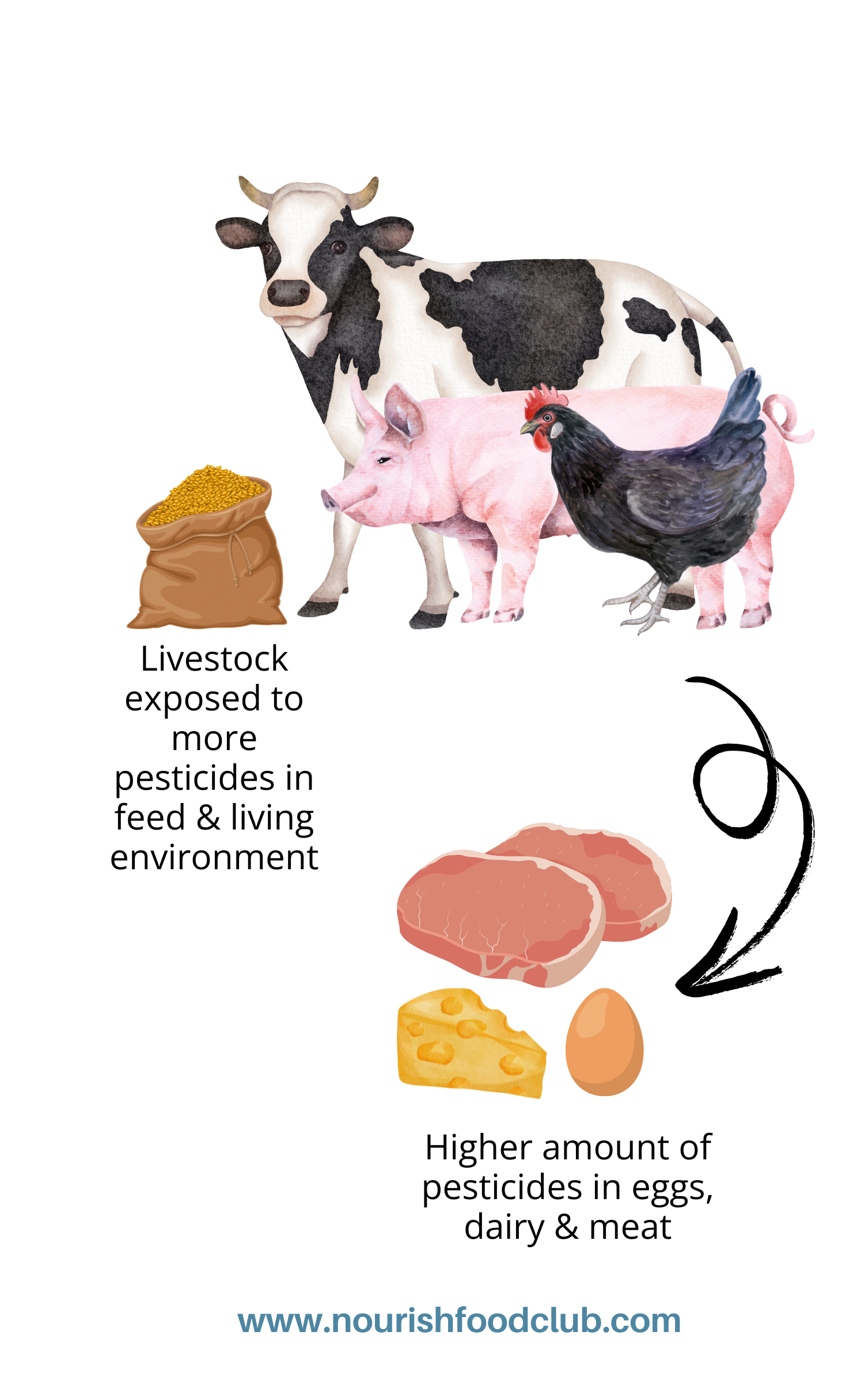


3. metabolism & gut disrupting pesticides
In addition to the rise of PUFAs and phytoestrogens in our food supply, another major shift is our growing exposure to pesticides - and it’s not just on produce.
Pesticides contaminate the entire food chain. In conventional crop production, they’re sprayed heavily on grains, fruits, and vegetables. But they also show up in meat, milk, and eggs.
Animals raised in confined, industrial systems are fed pesticide-laden grains and live in environments where toxic chemicals are routinely used to fight nature. These residues don’t just disappear - they accumulate in the animal’s fat, organs, and secretions, eventually ending up in the food we eat.
Chronic pesticide exposure is linked to endocrine disruption, fertility issues, gut disturbances, metabolic problems, and chronic disease development. It’s a slow, silent burden your biology was never designed to handle. And truth is, we don't yet fully understand the long term health consequences.
The “P” That’s Killing More Than Pests - Pesticides and Their Unseen Impact
Pesticides can change our gene expression, slowing down our metabolism even more - adding fuel to the fire that PUFAs and phytoestrogens have already started.
While humans have used natural pest control methods for thousands of years (think sulfur in ancient Sumeria, diatomaceous earth in ancient Egyptians, and chili pepper sprays used by Mesoamerican farmers) the era of toxic synthetic pesticides didn’t take root until the 1940s. And since then, it’s only accelerated.
Take glyphosate, for example, now a household name. Originally synthesized in 1970 as a metal chelator, it was repurposed by Monsanto into the now-infamous herbicide Roundup, introduced to the market in 1974. Glyphosate use exploded in the 1990s after genetically modified “Roundup Ready” crops were released - engineered to survive being drenched in the herbicide. This allowed farmers to blanket entire fields in glyphosate without harming the crops themselves. The result? Glyphosate use didn’t just increase - it skyrocketed by as much as 300-fold since the 1970s. (r)
So, we have to ask - what are the long-term health consequences of this massive chemical experiment? Truth is, we still don’t fully understand and still don’t have answers to.
Collapsible content

what are pesticides?
Let's break it down - Pest + Cide.
The term “pest” refers to any organism (insects, weeds, rodents, fungi, bacteria, etc.) that is considered harmful or undesirable, particularly in agricultural settings. And then “-cide” is a suffix derived from the Latin word caedere, meaning “to kill.”
The term ‘pesticides’ serves as an umbrella term for substances targeting and killing pests, with subcategories defined by the type of pest being addressed, such as herbicides for weeds, insecticides for insects, fungicides for fungi, rodenticides for rodents, nematicides for nematodes, bactericides for bacteria, molluscicides for slugs and snails, among others.
These chemicals are often formulated to target specific biological processes. For example, glyphosate blocks an enzyme in the shikimate pathway, which plants need but animals don’t have. Insecticides bind to neural receptors in insects. It sounds 'precise', but in reality, these chemicals tend to behave more like grenades than scalpels, often impacting far more than the intended targets.
Where do pesticides come from?
The health concerns make more sense when you understand where pesticides really came from - weapons of war repurposed for the farm.
After World War II, the same chemical manufacturing infrastructure built for warfare was redirected toward food production. Ammonium nitrate, once used in explosives, became synthetic fertilizer. Organophosphates, originally developed as nerve agents, were reformulated into insecticides. Yes, nerve agents. These chemicals disrupt how nerves transmit signals in the body. In war, they paralyze or kill. On farms, they “just” kill pests.
But it’s naïve to think that chemicals designed to destroy life come without collateral damage in our food system.
There are always consequences when we try to outsmart nature with chemistry.
And since pests adapt so quickly, we’re forced to keep developing newer, stronger chemicals, and using more of them over time - trapping farmers in a cycle of escalating toxicity that, conveniently, works out very well for chemical manufacturers.
Now, there’s a big difference between occasional use and total reliance. But much like the pill-popping culture fostered by Big Pharma, modern agriculture has become chemically dependent - relying on synthetic inputs to mask poor soil health, prop up monocultures, and force productivity in unnatural confinement systems.
Instead of addressing the root causes, we treat the symptoms.
And every chemical “solution” seems to create new problems in its wake.
For example - pollinators like bees and butterflies, soil microbes, birds, aquatic life - all can be harmed when these compounds drift into water and air, persist in soil, or contaminate food.
We’re exposed the same way - through the food we eat, the air we breathe, the water we drink. And the most vulnerable life forms, like the microbes in our gut, are often the most overlooked. Pesticides can destroy them, too.
Life is interconnected.
And when we chemically wage war on one part, there are always consequences somewhere else.
Has the government tested pesticides for safety?
Even the U.S. government admits there’s evidence pesticides can harm human health (r), yet they’ve completely dropped the ball. The agencies tasked with protecting us have delayed testing, missed deadlines, and allowed industry influence to dictate the pace of regulation.
And here’s the wild part: it’s been nearly three decades. Yes, three decades - and we’re still waiting on the government to run the most basic safety evaluations for pesticide chemicals that saturate our food, water, and soil.
Back in 1996, the Food Quality Protection Act (FQPA) was signed into law. (r) It required the EPA to screen pesticides for endocrine-disrupting effects (hormonal interference that can impact metabolism, reproduction, and development).
Before this, the 'Delaney Clause' took a strict stance on pesticides: any chemical at any amount shown to cause cancer in animals or humans was banned in food - no exceptions. But the FQPA replaced that with a more lenient risk-based model: if exposure was deemed “low enough,” the chemical could stay - even if it was hazardous. A massive win for pesticide manufacturers.
The law also required the EPA to create the Endocrine Disruptor Screening Program (EDSP), starting with a modest 52 chemicals out of over 80,000 in use. Testing was to occur in two tiers: Tier 1 to see if a chemical could affect hormonal systems, and Tier 2 to find out if it caused real harm. But the rollout was a disaster.
Tier 1 testing didn’t even start until 2009 - 13 years late. Most flagged chemicals were never followed up on. Tier 2? Still not validated. According to the EPA’s own site, no test orders have been issued with no plans to do so. (r) Meanwhile, pesticide use continues full steam ahead.
In 2021, the EPA’s Inspector General released an alarming report:(r)
- - Over 1,300 high-priority chemicals had been identified, yet few were screened.
- - The EPA moved the goalposts mid-process once they got the test results back from Tier 1, changing how results were evaluated.
- - Staff were reportedly told to act as if the program had been defunded.
Nearly 30 years later, the federal government still hasn’t fulfilled its legal obligation to screen pesticides for hormone-disrupting effects. This isn’t just regulatory delay - it’s regulatory capture in plaint sight. It's a textbook example of how Big Ag leverages its massive lobbying power to weaken oversight and stall reform. While corporations rake in profits, the public is left with the fallout: chronic exposure to poorly studied, potentially hormone-disrupting chemicals embedded in our food, water, and environment.
Do the chemicals go away?
Pesticides don’t just vanish after application. Many of these compounds are fat-soluble. This means when animals consume pesticide-laden feed or are exposed environmentally, the chemicals accumulate in their fat, organs, and milk. (r)
Eventually, they make their way into your body, too. (r,r) So when you eat conventional animal fats, you’re often getting a small, invisible dose of pesticide residues.
They also persist in the environment, moving far beyond the farm where they were applied.
Other pesticides are water-soluble or bind loosely to soil particles, allowing them to leach into streams, rivers, and groundwater. From there, they travel downstream, accumulating in larger bodies of water. This runoff is a major contributor to water pollution, carrying not just the pesticides themselves, but also nutrients like nitrogen and phosphorus from fertilizers, which can fuel harmful algal blooms.
The Gulf Coast provides a stark example of this process. Agricultural runoff from farms far upstream flows through rivers and eventually into the Gulf of Mexico, bringing with it both pesticides and excess nutrients. These chemicals disrupt aquatic ecosystems, kill or harm sensitive species, and contribute to “dead zones” where oxygen levels are too low to support marine life. Far from being confined to a single field or farm, the effects of pesticides are cumulative and far-reaching, demonstrating that these substances don’t simply disappear: they move through and persist in the environment, with consequences that ripple across landscapes and communities.
Are there pesticides in meat, milk & eggs?
Pesticides in animal agriculture are a hidden route of exposure
It’s common knowledge that pesticides are heavily used in conventional crop production: to deter pests during the growing season and, in some cases, as pre-harvest desiccants on grains like wheat, oats, barley, and legumes.
What’s far less discussed is the massive amount of pesticides used to grow livestock feed for both GMO and non-GMO systems.
Each year in the U.S., roughly 1 billion pounds of pesticides are applied to crops meant for human consumption. But another 250 to 300 million pounds are used solely on feed crops like corn, soybeans, and alfalfa. (r)
Even more alarming? Animal feed is not held to the same safety standards as human food.
Glyphosate residue limits in livestock feed can be up to 100 times higher than the legal limits for human food. Red meat is allowed to contain 20 times more glyphosate than most grain-based foods. (r)
But that’s only part of the story.
Beyond feed, pesticides are also widely used inside confinement animal feeding operations (CAFOs) to control the swarms of insects and rodents drawn to these unnatural, high-density environments.
Facilities like indoor chicken houses, hog barns, and cattle feedlots create perfect breeding grounds for pests and disease. And industrial agriculture relies heavily on chemical intervention to keep things manageable.
Here’s a few examples of how pesticides show up in CAFOs:
- - Rodenticides (like warfarin and bromethalin) are used around feed storage and manure piles to kill rats and mice.
- - Insecticides (like organophosphates and synthetic pyrethroids) are fogged, sprayed, or even mixed directly into feed to control flies, mites, and beetles.
- - Medicated feeds often include compounds like carbaryl, designed to kill both internal and external parasites.
One example is Methoprene, a ‘feed-through’ larvicide that is regularly added to feed rations in cattle feedlots and is designed to kill insect larvae before they hatch or mature. It doesn’t kill adult flies but instead disrupts larval development, breaking their lifecycle.
The cows consume it in their feed, some of it is stored, some of it is excreted in their manure, and when flies lay eggs in that manure, the larvae can’t mature - breaking the fly’s lifecycle at the source.
Sounds smart, right? But there are problems. The EPA exempts methoprene from residue testing in meat, milk, or animal fat, thanks to a regulatory exemption (40 CFR 180.1033). In fact, no maximum residue limit (MRL) exists and there is no routine monitoring. It’s considered “safe” based on how “quickly” it’s excreted. But in animal studies, methoprene residues showed up in the liver, kidneys, blood, and lungs.
While methoprene is primarily documented in cattle feedlots, similar larvicides, like diflubenzuron and cyromazine, are sometimes used in swine barns to manage flies through manure treatment. And in confinement poultry operations, insecticides such as permethrin and other pyrethroids are commonly applied to bedding and facility surfaces to control mites, lice, and beetles.
These aren’t isolated practices - they’re standard in confinement agriculture. So in addition to pesticide exposure from feed, animals in confinement systems are also exposed environmentally due to unnatural living conditions.
By contrast, pasture-based, rotational grazing systems don’t require these chemical interventions. When animals live in natural conditions, pests don’t spiral out of control.
This information helps us better understand why…
- - Glyphosate has been detected in eggs, dairy, and meat, despite the fact that these products aren’t sprayed directly.
- - Conventional dairy has tested positive for multiple pesticides (r), with some samples exceeding both U.S. and international safety limits. While contaminated feed is the primary route, environmental exposure within CAFOs also plays a role. (r)
- - Poultry feed is now recognized as a major source of pesticide contamination. (r)
- - Eggs have been found with glyphosate levels well above international safety thresholds (r,r) - one report showed samples with over 100 parts per billion (ppb). (r) Even organic, cage-free eggs have tested as high as 169 ppb, more than three times the EPA’s allowable limit of 50 ppb. (r,r)
This information tells us something important: pesticides are building up in the tissues of animals through their feed and environment - and that means it’s building up in humans, too.
So, what are the real-world consequences of regular pesticide exposure?
Some argue that our food supply is safe because it falls within EPA-established tolerance levels. But critics point out that these standards overlook key concerns: such as the compounding effects of consuming multiple contaminated foods daily over a lifetime. (r)
While each food might individually meet legal limits, the total daily intake from a varied diet can easily exceed a biologically significant dose over time.
Another major oversight: most glyphosate health studies focus only on glyphosate itself, not on the actual formulation used in agriculture: Roundup. Roundup combines glyphosate with surfactants like POEA and a cocktail of so-called “inert” ingredients, which may include solvents, preservatives, and anti-foaming agents, many of which are legally undisclosed. These added ingredients can dramatically increase toxicity.
In fact, multiple studies have shown that Roundup as a complete formulation is more harmful than glyphosate alone. (r,r) Testing isolated ingredients simply doesn’t reflect the reality of what we’re exposed to.
When you dig deeper, the health consequences of rising pesticide exposure become hard to ignore.
And because routine testing of food is rare unless a safety issue is flagged, these residues often enter the food system (and inside of you) quietly and undetected.
health consequences of pesticide exposure

Increases Disease Risk
The sharp rise in chronic illnesses - including cancer, autoimmune conditions, and metabolic disorders - may be partly driven by our ever-increasing exposure to environmental toxins, particularly pesticides. (r) For example, glyphosate, the most widely used herbicide globally, has been classified as a probable human carcinogen by the International Agency for Research on Cancer (IARC). (r) So its widespread presence in our food supply raises serious concerns.Pesticides have been shown to promote lipid oxidation and trigger the production of reactive oxygen species (ROS)(r,r,r) - damaging cellular lipids, proteins, and even DNA. (r,r) This oxidative injury disrupts cellular function and can drive ferroptosis, a form of cell death specifically triggered by lipid peroxidation. (r) Pesticides also weaken the body’s natural antioxidant defense systems (r,r), amplifying oxidative stress, chronic inflammation, and cellular damage over time. (r)This steady cellular degradation impairs tissue integrity and organ function, paving the way for long-term disease.Glyphosate in particular has been found to induce inflammation and oxidative stress in various cell types (r,r,r), contributing to DNA damage, increased cancer risk, and liver and kidney dysfunction. (r,r,r,r,r)And these pesticides don’t always just pass through the body - they can bioaccumulate in critical organs (r,r) such as the liver, kidneys, and colon (r,r,r) Glyphosate has even been shown to cross the blood-brain barrier and build up in the brain, where it may increase the risk of neurodegenerative diseases like Alzheimer’s. (r)Pesticides have also been detected in breast milk (r), which raises deep concerns about developmental impacts on the next generation. Pesticides consumed and stored in the mother’s body can be passed to infants during breastfeeding through milk, also cross the placenta and reach the fetus during pregnancy (r), exposing the fetus during critical windows of development, with potential long-term effects on growth, metabolism, and brain development. Alarmingly, evidence suggests that fetuses and infants are even more vulnerable to pesticide toxicity than adults, as their detoxification systems are still immature, especially during the fetal period and the first year of life. (r)
Severe Hormonal Disruptions
Pesticides are increasingly recognized as endocrine-disrupting chemicals (EDCs) - compounds that mimic, block, or interfere with hormone function. These disruptions can impact reproductive health, development, metabolism, and more. (r,r)
Pesticides can disrupt the endocrine system through several mechanisms: (r,r,r,r)
- - Mimicking natural hormones like estrogen or testosterone, contributing to widespread estrogen dominance alongside PUFAs and phytoestrogens
- - Blocking hormone receptors, preventing normal function
- - Altering hormone production, transport, or clearance
- - Disrupting the thyroid, adrenal, or insulin systems
Take atrazine, for example. It activates aromatase (r,r,r), the enzyme that converts testosterone into estrogen, reducing testosterone and raising estrogen levels, particularly dangerous in developing males.
There’s overwhelming and alarming evidence of reproductive and endocrine abnormalities in animals exposed to pesticides:
- - 5 weeks of glyphosate-laced feed reduced sperm motility in roosters and led to fatter offspring (r)
- - Wastewater from hog confinement buildings (loaded with pesticides) feminized male fish and masculinized females (r)
- - Atrazine exposure at low levels chemically castrated male frogs and caused hermaphroditism (r) – where an organism has both male and female reproductive organs and characteristics.
- - American alligators exposed to pesticides in utero developed malformed organs, high estrogen, low testosterone, low fertility rates and reversed sex traits. (r) “Ten percent of the exposed genetic males developed into functional females that copulated with unexposed males and produced viable eggs.”
- - DDT (now, thankfully outlawed) caused feminization in multiple bird species (r) and Seagull eggs exposed to DDT developed female traits regardless of genetic sex (r)
- - Numerous studies document ovotestis - the presence of both ovarian and testicular tissue - in fish, frogs, and rodents after pesticide exposure. (r,r,r) One study documents pictures of eggs developing in the testes of male frogs. (r)
And while many of these effects are documented in animals, the biological pathways are similar, suggesting humans are not immune. (r,r,r)
Plus, pesticide exposure is linked to a wide range of reproductive and hormonal issues in humans as well: (r,r,r,r,r)
- - Menstrual irregularities
- - Reduced fertility and prolonged time to conceive
- - Increased risk of miscarriage, stillbirth, and birth defects
- - Ovarian dysfunction
- - Elevated rates of breast and ovarian cancers linked to hormones
One study found that infertile women were three times more likely to have pesticide exposure. That risk jumped to ninefold for women working in conventional agriculture with very high pesticide exposure. (r)In another study, glyphosate and Roundup were shown to be cytotoxic and significantly reduce progesterone levels in human cells after just 24 hours of exposure at concentrations deemed acceptable in Australian drinking water (1 mg/L). (r)Progesterone and estrogen work in a delicate balance, like yin and yang. When progesterone drops, it tips the scale toward estrogen dominance - a hormonal imbalance that’s becoming increasingly common across the population.And the alarming reality is that more than 50 pesticide active ingredients have been identified as endocrine disruptors by scientific authorities (r), and not all of them that are currently used have been tested.
Disrupts Gut Health
Your gut is home to over 100 trillion microbes - bacteria, viruses, fungi, and other organisms that play critical roles in digestion, immunity, hormone metabolism, and even mood regulation.But here’s the problem: many of the same microbial traits that make your gut thrive are the very ones pesticides are engineered to destroy. (r) Out in the fields, these chemicals are used to kill bacteria, fungi, and pests - but once they enter your body through food, water, or air, they don’t suddenly lose their toxicity. They can disrupt the delicate balance of your gut ecosystem, wiping out beneficial microbes and allowing harmful ones to thrive.Studies link pesticide exposure to gut dysbiosis, reducing beneficial bacteria and encouraging growth of harmful species. (r,r) Some of these microbial shifts increase inflammation, intestinal permeability, and oxidative stress (r,r) - laying the groundwork for leaky gut, autoimmunity, and chronic illness.Glyphosate, in particular, is notorious for this. While human cells don’t use the shikimate pathway (the mechanism glyphosate targets), your gut microbes do. (r,r) And unfortunately, many beneficial microbes possess the glyphosate-sensitive version of the enzyme (r) - meaning they’re the first to die off. Meanwhile, opportunistic pathogens often carry glyphosate-resistant enzymes, allowing them to thrive. And don’t forget: microbial cells in your body outnumber human cells. Humans are made up of approximately 30 trillion human cells and about 39 trillion microbial cells, meaning the microbes in our gut slightly outnumber our human cells.So disrupting your microbiome isn’t a small side effect - it’s a fundamental threat to your health.
Lowers Metabolic Rate
Chronic pesticide exposure may also lower your metabolic rate, and this impacts you in two main ways:
- Increased fat storage – when your metabolism slows down, your body burns fewer calories at rest and during activity. This means your total “Calories Out” drops - so even if you’re eating the same amount, it’s easier to tip into a calorie surplus and gain fat. To maintain energy balance, you’d need to eat less than before, simply because your metabolic engine isn’t running as hot.
- Reduced energy production – when ATP production slows down, every cell in the body suffers. This leads to fatigue, poor organ function, and a general sense of not thriving.
Similar to PUFAs, many pesticide compounds block or downregulate key components of the body’s energy production system. These disruptions slow down your metabolic engine and shift your body toward fat storage.
Some pesticides, including glyphosate and boscalid, directly interfere with mitochondrial function - the part of the cell responsible for generating ATP, your body’s energy currency. (r,r,r) They block critical steps in the electron transport chain (ETC), reducing your ability to make energy efficiently.
For example, rotenone has been shown to inhibit Complex I of the ETC, while other pesticides impair electron transfer at various points in the chain (r), crippling cellular energy output. (r) Glyphosate has been shown to inhibit both Complex II and Complex III of the ETC. (r,r) It also acts as a chelating agent, binding to essential metal ions like iron, copper, zinc, manganese, calcium, and magnesium - all of which are critical cofactors for mitochondrial enzymes. By stealing these minerals, glyphosate further reduces mitochondrial energy production.Glyphosate inhibited the energy-linked function by 46 % in the mitochondria isolated from rat liver. (r) Of course the liver won't function properly with lower energy inputs!Glyphosate and RoundUp lower energy production in human sperm cells (r), which reduces sperm motility and sperm function, lowering fertility rates. On top of disrupting energy production, pesticides can promote fat storage. They increase the activity of enzymes that encourage lipogenesis (fat creation) while suppressing enzymes involved in fat oxidation. (r,r,r,r,r,r) Essentially, they tilt your metabolism toward storing calories rather than burning them.
Follow the Money
When agrochemical companies say pesticides are “safe,” ask yourself - who profits from that message?
This system isn’t about nourishment. It’s about yield, control, and profit. Built on lobbying, subsidies, and patented inputs, it locks farmers into chemical dependence while sidelining natural solutions.
It was never designed for your health - just shareholder returns.
So when they say “safe,” remember: it’s not about safety. It’s about sales.



the feed to fat connection
Let’s be real - you’re never going to eliminate all pesticide exposure. And that’s okay! Your body has built-in detox systems designed to handle small amounts of environmental toxins. But today's food system bombards us with levels our biology was never meant to handle.
You don’t have to be perfect. But you can be intentional. Choose high-quality, low-input foods when possible. Support farms that work with nature, not against it. Your body - and your future self - will thank you.
How livestock are raised and what they eat has a direct impact on the nutritional quality of your food and your exposure to hidden toxins. It doesn’t just affect the type of fat you’re eating (like the ratio of saturated to unsaturated fats), it also influences your intake of endocrine-disrupting compounds like phytoestrogens and pesticide residues.
Animals fed diets high in PUFAs, phytoestrogens, and pesticide-laced feed accumulate these compounds in their fat tissue. And when you consume their meat, milk, or eggs, you’re also consuming the byproducts of their environment and diet.
That’s why pasture-based, regenerative livestock systems are so powerful. When animals are rotated across healthy pastures and raised in harmony with nature, the need for toxic pesticides dramatically decreases. Parasite pressure stays low because animals aren’t trapped in their waste. They get fresh air, sunlight, and the ability to express natural behaviors: all of which boost their resilience and reduce the need for chemical interventions.
But here’s the nuance: pasture-raised does not automatically mean pesticide-free.
Chickens, for example, can’t survive on pasture alone. They require supplemental feed. And whether it’s chickens, pigs, goats, or cows - if that feed is cheap, GMO, conventional, or even non-GMO, it may still be contaminated with pesticides.
Many people assume non-GMO means clean, but that’s a misunderstanding. Non-GMO does not mean chemical-free. In fact, non-GMO grains can still be grown using synthetic fertilizers, herbicides like glyphosate, fungicides, and insecticides. Glyphosate is widely sprayed not only on GMO crops but also on non-GMO and even some pre-harvest conventional crops like wheat, oats, and legumes. (r)
So when evaluating animal products, it’s not always enough to look for “pasture-raised” or “non-GMO.” You also want to understand how the animals were raised and what they were fed.
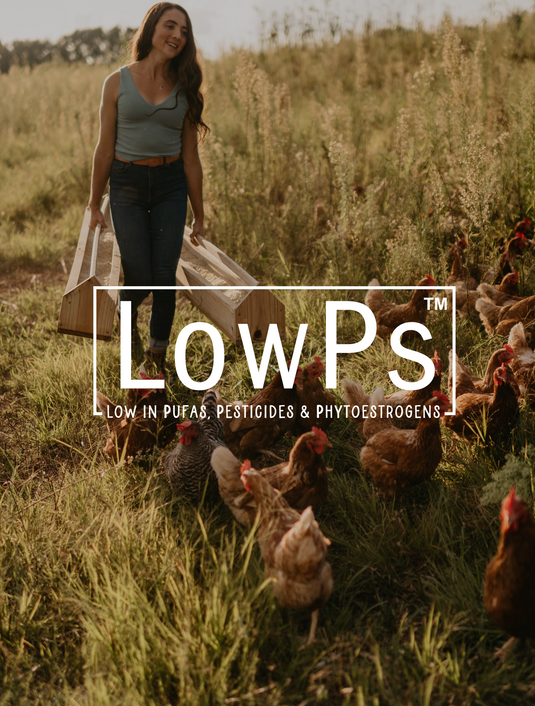

The Nourish LowPs™ Standard: Because It Matters What Animals Eat & How they were raised
We don’t believe in a food system dependent on synthetic agrochemicals. But instead of chasing a certification label like “organic” - which often comes with compromises and loopholes.
While the USDA organic label may be a step in the right direction, it’s not our north star. For example, Organic soybeans still have the same amount of PUFAs and Phytoestrogens that non-organic soybeans have.
We’ve chosen a different path. One that’s more transparent, more rigorous, and more intentional.
We believe real transparency goes deeper than a checkbox list of approved inputs. We wanted more control, more customization, and higher standards. So we built a system rooted in trust and real relationships, not just paperwork.
Here’s how:
- Regenerative & Sustainable - Our farm partners practice holistic, rotational grazing—mimicking natural ecosystems. This means no synthetic pesticides, no chemical fertilizers, and no toxic treatments needed. Livestock, produce, and grains thrive in these systems by design, not by force.
- Custom-Made, Low-PUFA Feed - Most farms buy bulk feed without knowing where it comes from or what’s in it. Not us. We developed our own custom feed, crafted to be low in PUFAs (the fats found in seed oils) and low in phytoestrogens. Because you are what you eat, eats. This level of customization helps us shape the fatty acid profile, phytoestrogen level and nutritional quality of our food from the inside out.
- Seed to Fork Transparency - We don’t just formulate the feed - we know exactly where the ingredients are grown. We work directly with regenerative row crop farmers to grow our grains without the heavy reliance on synthetic pesticides. This allows us full oversight and traceability, ensuring everything from the soil to the final bite aligns with our values.
join nourish food club
Our nutrient-dense, farm-fresh foods are available exclusively to Private Food Club Members. Join today for just $1 and gain access to food you can feel good about.
Our nutrient-dense, farm-fresh foods are available exclusively to Private Food Club Members. Join today for just $1 and gain access to food you can feel good about.
We help take the guesswork out of food sourcing - no more confusing labels or hidden toxins. Choose your favorite items, add to cart, and finally check out with confidence.
We help take the guesswork out of food sourcing - no more confusing labels or hidden toxins. Choose your favorite items, add to cart, and finally check out with confidence.
Enjoy truly nourishing food delivered right to your door - real ingredients that fuel your body, support your health, and nourish your family the way nature intended.
Enjoy truly nourishing food delivered right to your door - real ingredients that fuel your body, support your health, and nourish your family the way nature intended.


















